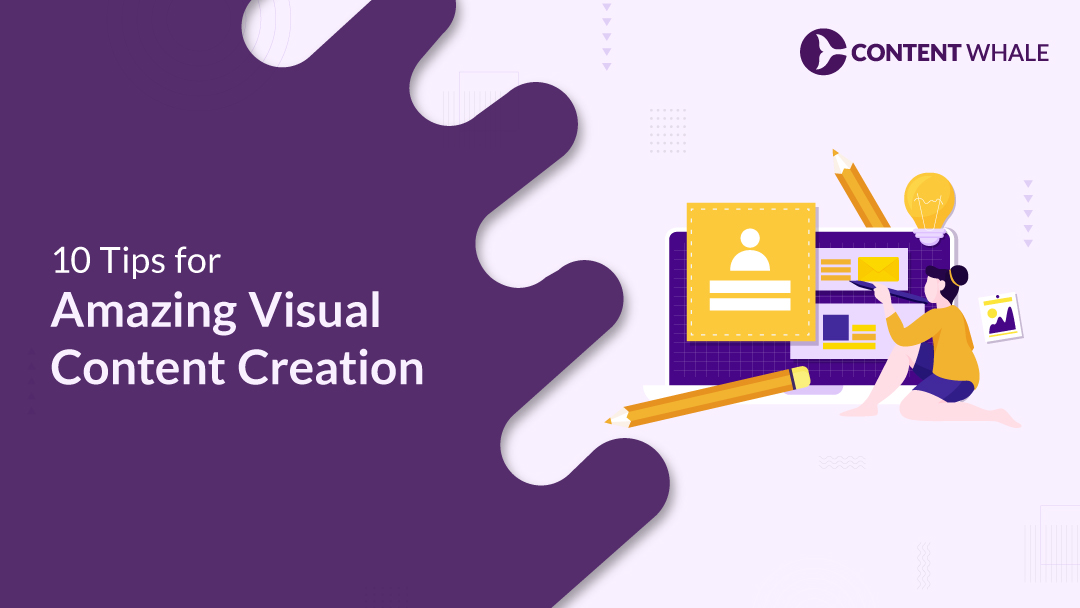Visual content has become a cornerstone of effective digital marketing. As audiences increasingly favor visual storytelling, integrating high-quality visuals into your online strategy is essential for capturing attention and driving engagement.
In this blog, we’ll cover 10 actionable tips that will guide you in creating compelling visual content that not only aligns with your brand but also resonates with your audience.
Whether you’re just starting out or looking to refine your approach, these insights will help you elevate your visual content creation efforts.
Visual Content Creation Tip #1: Understand Your Audience
The foundation of successful visual content creation lies in understanding your audience.
Start by researching their preferences, interests, and behaviors. Are they drawn to vibrant digital graphics or do they prefer minimalistic designs?
Use data from previous campaigns and social media analytics to inform your content visuals.
Tailoring your visual strategy to meet the specific tastes of your audience ensures that your content resonates, making it more likely to engage them.
Understanding what your audience wants will help you craft visual marketing efforts that hit the mark every time.
Visual Content Creation Tip #2: Use High-Quality Images and Videos
Quality is key when it comes to visual content. High-resolution images and videos not only look professional but also enhance the viewer’s experience.
Invest in good photography and videography, or utilize high-quality stock photos and footage when necessary.
This ensures that your visual content looks polished and professional. Remember, in the crowded space of online marketing, blurry or low-quality visuals can turn your audience away.
Always aim for clarity and sharpness in your content visuals to make a lasting impact.
Visual Content Creation Tip #3: Maintain Consistent Branding

Consistency in branding is crucial for recognition and trust. Ensure that your visual content consistently uses your brand’s colors, fonts, and overall style.
Develop a visual style guide to help maintain uniformity across all platforms. This consistency not only strengthens your brand identity but also makes your content more memorable.
Whether you’re creating social media graphics, website visuals, or video content, sticking to your brand’s visual identity is key to building a cohesive and recognizable presence.
Visual Content Creation Tip #4: Keep it Simple and Clear
In visual content creation, less is often more. Avoid cluttering your designs with too many elements or messages.
Focus on one central idea per visual, and use white space effectively to make the content more digestible. Simplicity doesn’t mean boring; it means clarity.
A clear, simple design can be more powerful and engaging than a complicated one.
By keeping your visuals straightforward, you ensure that your audience can easily understand and connect with your message, enhancing the overall impact of your visual marketing efforts.
Visual Content Creation Tip #5: Leverage Infographics
Infographics are a powerful tool for presenting data and complex information in a visually engaging way. They make it easier for your audience to grasp detailed information quickly.
Use infographics to break down statistics, explain processes, or highlight key facts. This type of content creation is particularly effective in educational contexts where you need to make intricate concepts accessible.
Incorporating infographics into your visual strategy not only adds variety to your content but also positions your brand as a helpful resource, boosting engagement and sharing.
Visual Content Creation Tip #6: Optimize for Different Platforms

Different platforms have different requirements, so optimizing your visual content for each one is essential. Adjust dimensions and file sizes to ensure your visuals look good on all devices and social media channels.
For instance, the ideal dimensions for a Facebook post differ from those of an Instagram story. By tailoring your content creation process to the specific needs of each platform, you ensure maximum impact and reach.
Additionally, take advantage of platform-specific features like Instagram’s carousel posts or LinkedIn’s document sharing to further enhance your visual strategy.
Visual Content Creation Tip #7: Tell a Story with Your Visuals
Visual storytelling is a compelling way to connect with your audience. Use images and videos to create a narrative that engages emotions and draws viewers in.
Sequential storytelling, where visuals are presented in a series that unfolds a story, can be particularly effective.
This approach not only captivates your audience but also makes your content more memorable.
Whether through branding visuals or social media graphics, telling a story helps to humanize your brand and build a deeper connection with your audience.
Visual Content Creation Tip #8: Use Creative Tools and Software
The right tools can make a world of difference in your visual content creation.
Leverage powerful design software like Adobe Creative Suite for professional-grade visuals, or explore user-friendly online tools like Canva and Visme for quick and creative designs.
Staying updated with the latest design technologies can give you a competitive edge.
These tools offer a range of features that can help you bring your visual strategy to life, whether you’re creating simple social media graphics or complex branding visuals.
Visual Content Creation Tip #9: Incorporate Your Logo Strategically

Your logo is a vital part of your brand identity, so it should be incorporated into your visual content, but with care.
Ensure that it’s visible without being overwhelming. Place your logo in a consistent location across all visuals, whether it’s at the bottom corner of a social media graphic or subtly integrated into a video.
This consistency helps enhance brand recognition without distracting from the main content. A strategically placed logo can reinforce your brand and make your visual marketing efforts more effective.
Visual Content Creation Tip #10: Test and Iterate
The process of creating visual content doesn’t end with publishing; testing and iteration are crucial for ongoing improvement.
Gather feedback from your audience to understand what resonates and what doesn’t. Use A/B testing to compare different visuals and find out which ones perform better.
This data-driven approach allows you to refine your visual strategy continuously.
By regularly testing and iterating, you can ensure that your visual content remains effective and aligned with your marketing goals, leading to better engagement and results over time.
Conclusion

In summary, these 10 tips offer a comprehensive guide to creating high-quality visual content that stands out in the crowded field of online marketing.
From understanding your audience to leveraging the latest tools, each tip is designed to enhance your visual strategy and help you achieve your marketing goals.
Good visual content can significantly boost your brand’s visibility and engagement, making it a crucial element of any successful online marketing campaign.
If you’re looking to elevate your visuals, consider partnering with Content Whale’s expert team. Our professional content creation services are tailored to help you captivate your audience and drive results.
FAQs
1. Why is visual content important in online marketing?
Visual content is essential in online marketing because it grabs attention and communicates messages quickly and effectively. With the increasing competition for audience engagement, high-quality visuals can make your content stand out.
Whether it’s social media graphics, digital graphics, or video content, visually appealing material is more likely to be shared, remembered, and acted upon.
This makes visual content a powerful tool for enhancing your overall content creation and visual strategy, ensuring that your marketing efforts resonate with your target audience.
2. What tools can I use to create high-quality visuals?
There are numerous tools available for creating high-quality visual content, depending on your needs and skill level.
For professional-grade design, Adobe Creative Suite offers comprehensive options for graphic design and video content creation. If you’re looking for more user-friendly tools, Canva and Visme are excellent for creating social media graphics and infographics with minimal design experience.
These tools help you produce polished and consistent branding visuals that can elevate your online marketing efforts. Staying updated with the latest graphic design tips and tools will keep your visual strategy fresh and effective.
3. How do I maintain consistent branding in my visual content?
Maintaining consistent branding in your visual content is crucial for building a strong brand identity. Start by developing a visual style guide that outlines your brand’s colors, fonts, and design elements.
Use this guide to ensure that all your digital graphics, social media graphics, and other content visuals are aligned with your brand’s identity.
Consistency in branding across all platforms helps reinforce your brand’s message and makes your content instantly recognizable to your audience, which is a key aspect of a successful visual marketing strategy.
4. What are the best practices for using infographics?
Infographics are an excellent way to present complex information in a visually engaging format. The best practices for using infographics include focusing on clarity and simplicity.
Break down data into digestible chunks and use visuals like charts, icons, and illustrations to make the information easy to understand. Infographics should be used strategically in your content creation to educate and inform your audience while keeping them engaged.
Whether used in blog posts, social media posts, or email campaigns, infographics are valuable tools for enhancing visual storytelling and marketing tips.
5. How can I optimize visual content for different social media platforms?
Optimizing visual content for different social media platforms involves tailoring digital graphics to each platform’s specific requirements.
This includes adjusting dimensions, file sizes, and even the type of content you share. For example, vertical formats work well on Instagram Stories, while landscape formats are preferred on YouTube.
Additionally, consider the platform’s audience and how they engage with content. Use platform-specific features like Instagram’s carousel posts or Pinterest’s rich pins to enhance your visual strategy. This tailored approach ensures that your content visuals are effective and engaging across all platforms.





